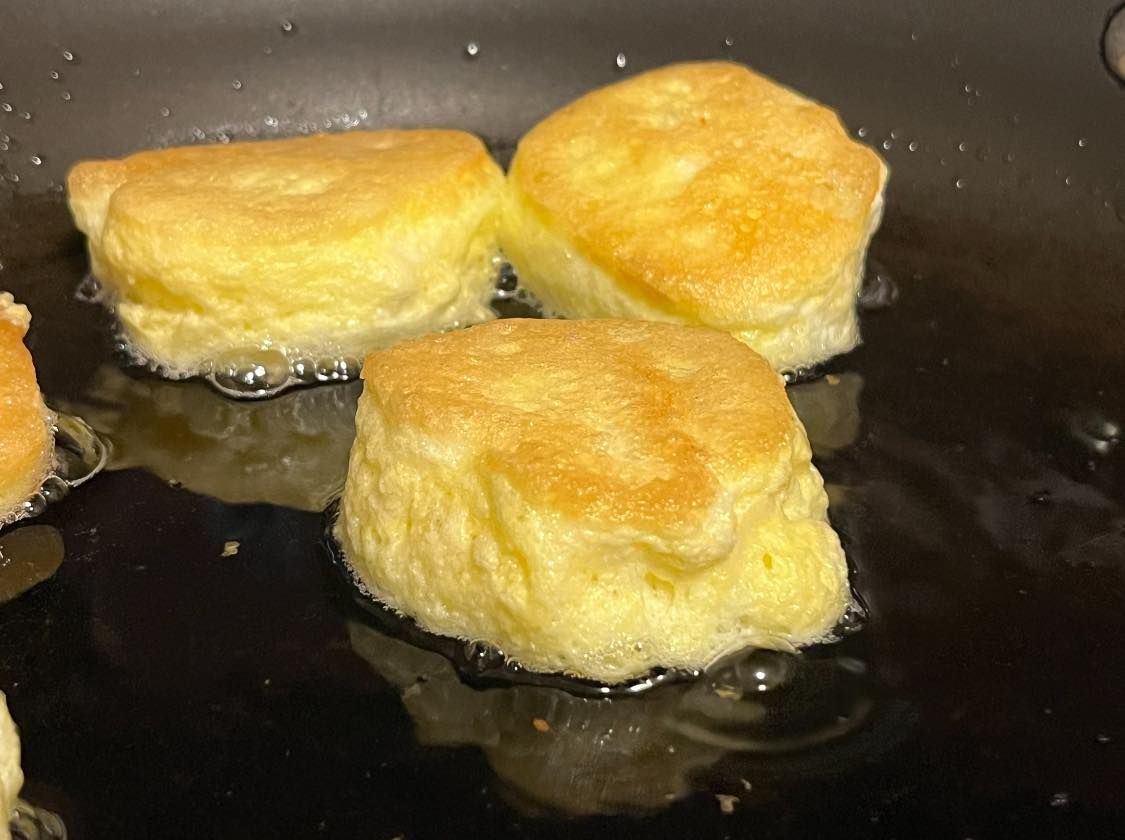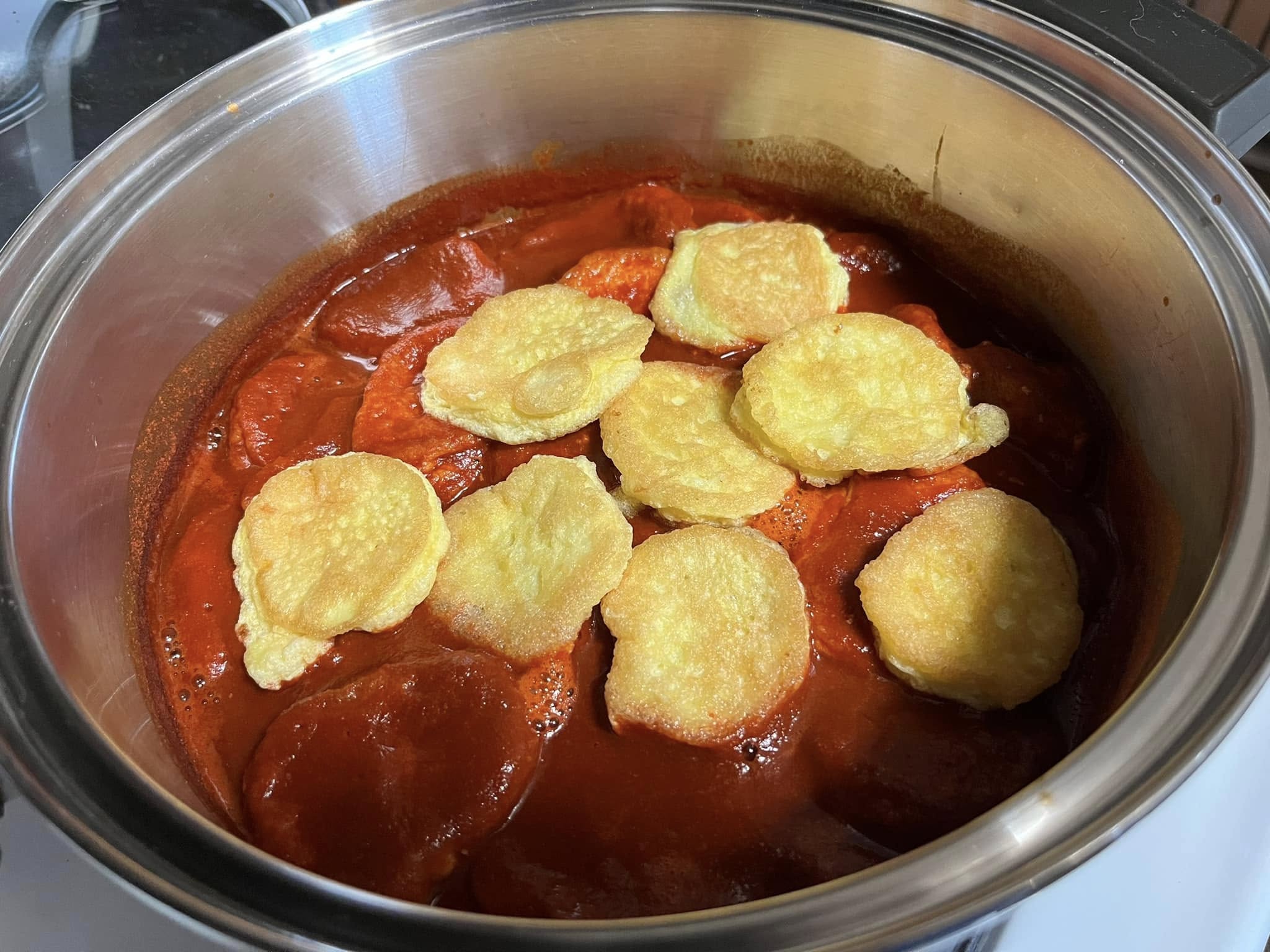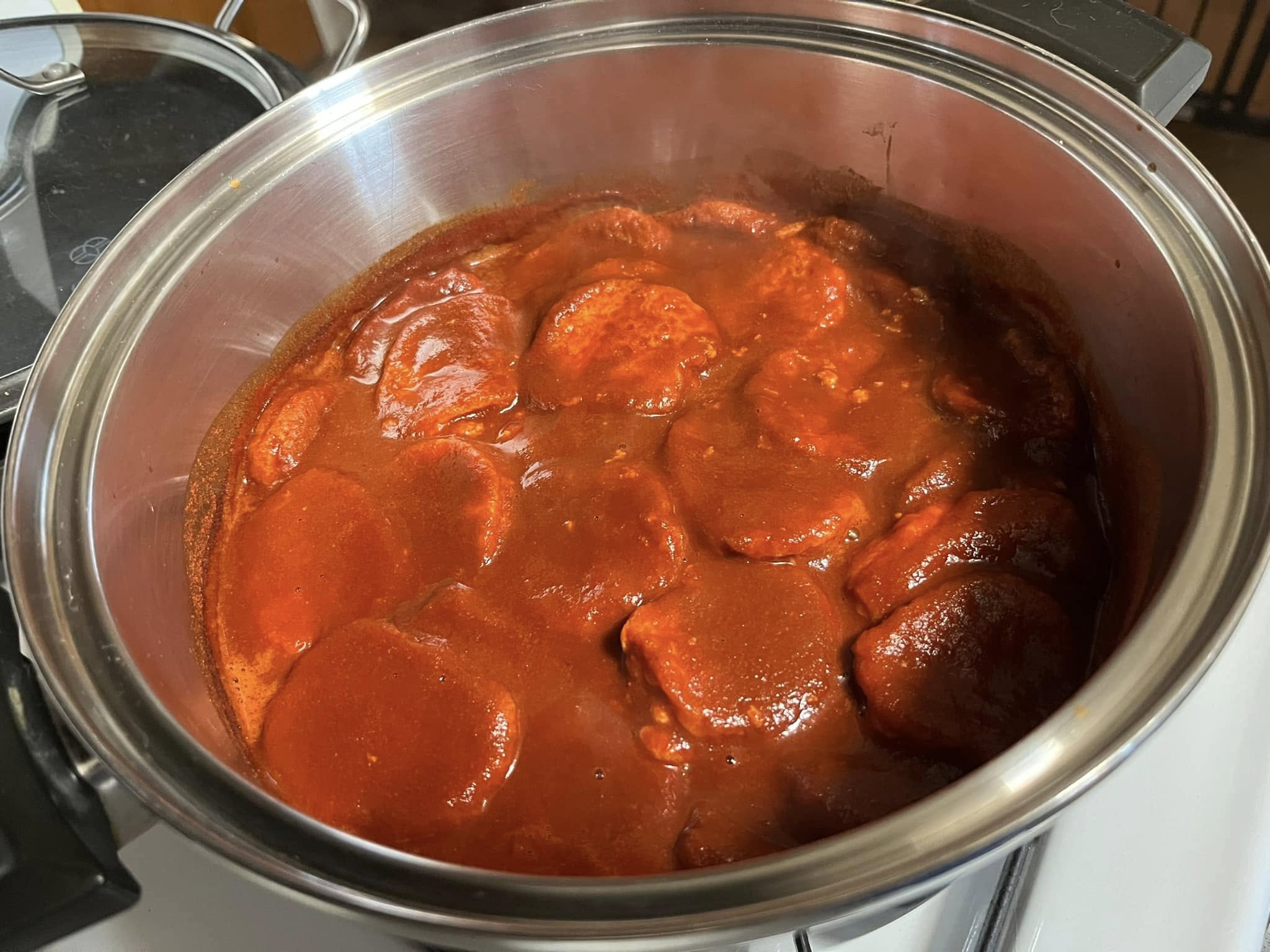Tortas de Huevo
Tortas de Huevo are more than just a humble meal—they’re a taste of tradition passed down through generations of New Mexican kitchens.
Light and airy egg fritters, golden from frying in manteca, are gently simmered in a rich, earthy red chile sauce that carries both warmth and memory in every bite. This dish is simple yet soulful, often gracing the table during Lent, family gatherings, or quiet Sunday dinners.
Served with warm tortillas or rice, it’s the kind of comfort that feeds more than hunger—it feeds heritage.

Why People Will Love This Tortas de Huevo Recipe:
Deep cultural roots – This dish is a treasured staple in New Mexican cuisine, often tied to family traditions, holidays, and Lenten meals. It offers a connection to heritage with every bite.
Light yet rich texture – The egg whites are whipped until airy and then folded with yolks and flour, creating fritters that are fluffy inside with a golden, crisp exterior.
Bold, earthy flavor – When paired with homemade red chile sauce, the tortas absorb deep smoky heat, giving the dish a rustic intensity that’s deeply satisfying.
Simple, humble ingredients – Made from pantry basics—eggs, flour, salt, lard—it proves that incredible flavor doesn’t require complexity or expense.
Versatile and comforting – Served with tortillas, rice, or even beans, this dish brings comfort, nourishment, and flexibility to any table. It’s both everyday and ceremonial.

Key Ingredients:
Eggs – The heart of the dish, eggs are transformed from simple pantry staples into light, airy fritters. Beaten whites give structure and lift, while the yolks bring richness and color, making each torta delicate yet deeply satisfying.
All-purpose flour – Just enough to bind the eggs without weighing them down. It helps create a slight crispness on the outside while keeping the interior tender and soft.
Salt – A small but essential ingredient that enhances the natural flavor of the eggs and balances the richness of the dish. It’s subtle, but it grounds the whole recipe.
Manteca (lard) – Traditional and flavorful, lard adds more than just fat for frying—it contributes an authentic, savory depth and a golden, crisp finish to the tortas that vegetable oil simply can’t replicate.
Basic Red Chile Sauce – More than just a topping, this sauce is the soul of the dish. Its deep, earthy, smoky heat infuses the egg fritters with bold New Mexican flavor, transforming the simple into the extraordinary.

Expert Tips:
Whip egg whites to stiff—but not dry—peaks
Beating the egg whites until they hold firm peaks creates the iconic fluffy texture of tortas. Avoid over-whipping, which can cause them to separate or collapse when folded with the yolks.
Fold gently to preserve airiness
When combining the whipped whites with the yolks and flour, use a gentle folding motion—not stirring. This maintains the volume in the mixture and results in lighter, more delicate fritters.
Use traditional manteca for authentic flavor and texture
Lard isn’t just for frying—it adds a subtle richness and helps develop a beautifully golden crust. For a more authentic New Mexican taste, use high-quality rendered lard if available.
Don’t overcrowd the pan
Fry in small batches to keep the oil temperature consistent. Overcrowding causes the temperature to drop, leading to greasy, unevenly cooked tortas.
Add tortas to warm red chile sauce just before serving
To avoid soggy fritters, place the cooked tortas into gently warmed chile sauce right before serving. Let them soak briefly so they absorb the flavor but retain some texture.
Serve with warm tortillas or rice to complete the experience
Tortas de Huevo are best enjoyed with soft tortillas to scoop up the chile and eggs, or with rice to absorb the bold, smoky sauce. It transforms the dish into a full, comforting meal.

Tortas de Huevo
Yield: 4–6 servings
Temperature: Medium-High
Ingredients:
3 tablespoons manteca (lard, for frying)
4 large eggs
2 tablespoons all-purpose flour
½ teaspoon salt
1 recipe Basic Red Chile sauce (for serving)
Instructions:
In a heavy skillet, heat the manteca (lard) over medium-high heat until hot.
While the lard heats, separate the egg whites into a mixing bowl. Using a hand or stand mixer, beat the egg whites until they form stiff peaks.
Gently beat in the egg yolks, then add the flour and salt. Mix until fully combined and smooth.
Carefully drop the egg mixture into the hot lard by the teaspoonful, forming small fritters.
Fry each fritter until golden brown on all sides, turning as needed.
Remove and place on paper towels or an absorbent surface to drain excess oil.
Transfer the cooked tortas to the prepared red chile sauce, gently stirring to coat.
Serve immediately while hot, ideally with warm tortillas or rice on the side.
Important Notes When Making Tortas de Huevo:
This is a heritage dish rooted in New Mexican cuisine
Tortas de Huevo are not just simple egg fritters—they’re a traditional Lenten dish, often served during Holy Week. Their pairing with red chile ties them deeply to the culinary identity of Hispanic communities in the Southwest U.S.
The texture relies entirely on proper egg handling
The light, sponge-like interior of the tortas depends on correctly beaten egg whites. If they’re under-beaten, the tortas will be dense. If over-beaten, they may separate when mixed with yolks.
Flour is minimal and functional, not for structure
The small amount of flour in this recipe isn’t meant to form a dough—it’s simply a stabilizer to help bind the airy egg mixture. Adding too much will result in a heavy, pancake-like texture.
Red chile is not optional—it’s essential
The red chile sauce isn’t just a topping; it’s what defines the dish. The earthiness of the chiles balances the richness of the egg fritters. Homemade chile using Chimayo or Hatch chile powder provides an unmatched depth of flavor.
This dish is best enjoyed freshly made
Tortas lose their puffiness over time. For the best eating experience, serve them within minutes of frying and soaking in warm chile. Leftovers can be refrigerated but will have a denser texture when reheated.
Egg separation and temperature matter
Cold eggs are easier to separate, but egg whites whip better at room temperature. So, separate them when cold, then let them sit for 10–15 minutes before whipping.
How To Enjoy Tortas de Huevo After Cooking
Serve Immediately While Hot
These egg fritters are at their peak right after frying—light, airy, and golden with a delicate crispness. Let them rest briefly on a paper towel to absorb excess oil, but serve them within minutes for the best texture.
Smother Generously in Red Chile Sauce
Place the tortas in a shallow bowl or plate, then ladle warm red chile sauce over them. The sauce should be slightly thick and rich with earthy spice—ideally homemade using Chimayo or Hatch chile powder for authentic flavor.
Pair with Traditional Sides
- Warm flour tortillas: Perfect for scooping up the tortas and chile.
- Steamed rice or Spanish rice: Helps soak up the sauce.
- Frijoles de la olla (whole cooked beans) or refried beans: Adds a creamy, hearty contrast.
Garnish Thoughtfully
- A sprinkle of chopped cilantro adds brightness.
- A light squeeze of lime enhances the chile’s depth.
- Thinly sliced radishes or pickled onions provide crunch and acidity.
Eat Like a Local
Use a spoon or fork for the tortas, but keep warm tortillas close at hand to scoop, dip, and wrap bites of egg, chile, and side dishes together. It’s comforting, communal, and deeply satisfying.
Save Leftovers (If Any) Wisely
If you have extra tortas, store them separately from the chile to preserve texture. Reheat the tortas briefly in a toaster oven or skillet before smothering with reheated sauce. While not as airy as fresh, they’ll still be flavorful and hearty.
Nutrition Information
For one serving of Tortas de Huevo with Red Chile Sauce (based on 6 servings total):
Calories: 180 kcal | Total Fat: 14.2 g | Saturated Fat: 4.2 g | Monounsaturated Fat: 6.1 g | Polyunsaturated Fat: 1.3 g | Cholesterol: 140 mg | Sodium: 260–320 mg (depending on chile sauce and added salt) | Total Carbohydrates: 6.5 g | Dietary Fiber: 1.1 g | Sugars: 1.4 g | Protein: 6.3 g
Frequently Asked Questions:
Can I use oil instead of lard for frying the tortas?
Yes, you can substitute vegetable or canola oil for lard if preferred. However, using lard provides a more authentic flavor and richer texture, traditional in many New Mexican and Mexican households.
How do I prevent the tortas from falling apart in the pan?
Make sure the egg whites are beaten to stiff peaks and fully combined with the yolks and flour. Drop the mixture gently into hot oil and avoid overcrowding the pan, which helps each torta set and brown evenly.
Can I make the tortas ahead of time and reheat them later?
You can, but they are best served fresh. If needed, store them in the fridge and reheat in a skillet or oven until warmed through. Reheating in sauce may cause them to soften, so add them to the chile just before serving.
What kind of red chile sauce works best with this recipe?
A homemade Basic Red Chile Sauce made with dried New Mexican or Chimayo chiles is ideal. It should be smooth, well-seasoned, and not overly spicy—meant to complement the light, fluffy egg fritters.
Are these tortas vegetarian or gluten-free?
They are vegetarian but not gluten-free, due to the addition of all-purpose flour. For a gluten-free version, substitute with a 1:1 gluten-free flour blend that can hold the structure when fried.
Why do I need to beat the egg whites separately?
Beating the egg whites separately until stiff peaks form creates a light and airy texture, which is key to achieving fluffy, cloud-like tortas. Skipping this step would result in flatter, denser fritters.
Can I skip the flour or replace it with something else?
The flour acts as a stabilizer, helping the tortas hold their shape during frying. You can replace it with a gluten-free flour blend or even fine masa harina, but the texture may vary slightly.
How hot should the oil be for frying?
The lard (or oil) should be medium-high heat, ideally around 350°F (175°C). If the oil is too cool, the tortas will absorb too much fat; if too hot, they’ll brown too quickly on the outside while staying undercooked inside.
Why are my tortas greasy or soggy?
This usually happens if the oil isn’t hot enough or the tortas were left in the oil too long. Make sure to preheat the oil properly and drain the tortas immediately on a paper towel after frying to remove excess oil.
Can I make the tortas without a mixer?
Yes, but it will take more time and effort. Use a whisk to beat the egg whites by hand in a clean, dry bowl. Be patient and consistent—stiff peaks are still possible without an electric mixer.